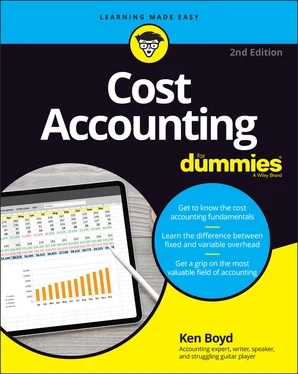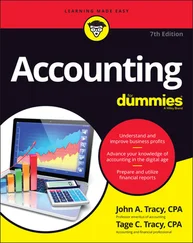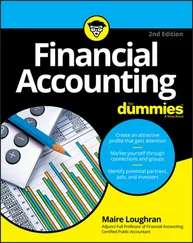Kenneth W. Boyd - Cost Accounting For Dummies
Здесь есть возможность читать онлайн «Kenneth W. Boyd - Cost Accounting For Dummies» — ознакомительный отрывок электронной книги совершенно бесплатно, а после прочтения отрывка купить полную версию. В некоторых случаях можно слушать аудио, скачать через торрент в формате fb2 и присутствует краткое содержание. Жанр: unrecognised, на английском языке. Описание произведения, (предисловие) а так же отзывы посетителей доступны на портале библиотеки ЛибКат.
- Название:Cost Accounting For Dummies
- Автор:
- Жанр:
- Год:неизвестен
- ISBN:нет данных
- Рейтинг книги:4 / 5. Голосов: 1
-
Избранное:Добавить в избранное
- Отзывы:
-
Ваша оценка:
- 80
- 1
- 2
- 3
- 4
- 5
Cost Accounting For Dummies: краткое содержание, описание и аннотация
Предлагаем к чтению аннотацию, описание, краткое содержание или предисловие (зависит от того, что написал сам автор книги «Cost Accounting For Dummies»). Если вы не нашли необходимую информацию о книге — напишите в комментариях, мы постараемся отыскать её.
Cost Accounting For Dummies
Cost Accounting For Dummies
Cost Accounting For Dummies — читать онлайн ознакомительный отрывок
Ниже представлен текст книги, разбитый по страницам. Система сохранения места последней прочитанной страницы, позволяет с удобством читать онлайн бесплатно книгу «Cost Accounting For Dummies», без необходимости каждый раз заново искать на чём Вы остановились. Поставьте закладку, и сможете в любой момент перейти на страницу, на которой закончили чтение.
Интервал:
Закладка:
You’re someone who needs an easy-to-read overview of cost accounting. Also, you want to investigate the topics that are used the most often to solve problems. You may be reading this book while taking a cost accounting course, but a business owner who needs more cost accounting knowledge should also find value in reading it.
You’re able to follow basic arithmetic and algebra. Many items you need to calculate appear in the form of equations. Accountants love to create an x or y variable and then solve for that variable, using an equation.
You have a beginner’s-level knowledge of how a business works. You understand that sales less expenses equals profit. You’re aware that a business needs to have capital (cash, equipment, and so forth) to operate.
You’re willing to read, pause, and assess what you’ve read. Learning cost accounting takes some effort. It’s not the sort of thing you can rush through. Whereas the text makes it easy to find information, it takes some effort to understand what you read. After you get it, you can use cost accounting to improve your business for years to come.
Icons Used in This Book
To make this book easier to read and simpler to use, I include some icons that can help you find and fathom key ideas and information.
 This icon appears whenever an idea or item can help reinforce your understanding of a concept. A tip might make it easier to remember a topic.
This icon appears whenever an idea or item can help reinforce your understanding of a concept. A tip might make it easier to remember a topic.
 Any time you see this icon, you know the information that follows is so important that it’s worth reading more than once.
Any time you see this icon, you know the information that follows is so important that it’s worth reading more than once.
 This icon flags information that’s a big concern. Warnings critical to your business are tagged with this type of icon.
This icon flags information that’s a big concern. Warnings critical to your business are tagged with this type of icon.
 This icon appears next to information that’s interesting but not essential. Don’t be afraid to skip these paragraphs. But come back at a later date and check them out. They’ll be waiting for you.
This icon appears next to information that’s interesting but not essential. Don’t be afraid to skip these paragraphs. But come back at a later date and check them out. They’ll be waiting for you.
Beyond the Book
In addition to the abundance of information and guidance related to cost accounting that we provide in this book, you get access to even more help and information online at Dummies.com . Check out this book’s online Cheat Sheet. Just go to www.dummies.com and search for “Cost Accounting For Dummies Cheat Sheet.”
Where to Go from Here
This book is organized so that you can go wherever you want to find complete information. Want to know about product pricing, for example? Head to Chapter 12. If you’ve taken an accounting course or two, start at Chapter 3with cost-volume-profit. You can use the table of contents to find broad categories of information or use the index to look up more specific topics.
If you’re not sure where you want to go, you may want to start with Part 1. It gives you all the basic info you need to understand cost accounting and points to places where you can find more detailed information.
Part 1
Understanding the Fundamentals of Costs
IN THIS PART …
So you’re ready to learn all there is to know about cost accounting. You’ve come to the right place! Part 1 introduces cost accounting terms as well as some basic methods of analysis.
You compare cost accounting to other accounting methods and learn four important cost terms: direct costs, indirect costs, fixed costs, and variable costs.
You also find out about product and period costs, cost-volume-profit (CVP) analysis, and job costing. Process costing and the flow of manufacturing is also looked at.
Chapter 1
So You Want to Know about Cost Accounting
IN THIS CHAPTER
 Understanding accounting methods
Understanding accounting methods
 Comparing cost accounting systems
Comparing cost accounting systems
 Controlling your costs
Controlling your costs
 Applying a price to your product
Applying a price to your product
 Mulling over quality issues
Mulling over quality issues
In a nutshell, cost accounting is the process of analyzing and planning what it costs to produce or supply a product or service. The analysis helps reduce costs — and possibly eliminate them. Lower costs, of course, allow for increased profits.
Business folks use cost accounting to determine the profitability of a product. The rule is simple: The price should cover the product cost and generate a profit. Competition may dictate the price charged for a product. In other instances, a profit is added to a product cost to create a unique price.
This chapter introduces cost accounting and how to compare and contrast cost accounting with other accounting methods. The chapter also explains how cost accounting can help you improve your business, such as by using pricing, budgeting, and other tools that can help you become more profitable.
Comparing Accounting Methods
Accounting is the process of recording, reporting, and analyzing business transactions. It’s the written record of a business. Cost accounting is the process of capturing all the costs of “production,” whether a business manufactures products, delivers services, or sells retail items. Cost accounting is used for all types of businesses.
Often, cost accounting overlaps with other types of accounting, such as financial accounting and management accounting. If you have some knowledge about these other areas of accounting, that background can help you understand cost accounting. If not, no big deal. This section helps clarify what cost accounting is, how it’s used, and how these accounting methods relate.
Financial accounting is a reporting process. An accountant reports on the financial position of a firm and the firm’s performance by creating financial statements. The statements are mainly used by external (outside) parties to show how the company is doing. External parties include shareholders, creditors, and regulators.
The external parties may not have an accounting background, so there are many rules of the road (and they are very specific) for creating financial statements. The rules exist so that each set of financial statements is standardized. If all companies follow the same set of rules to create financial statements, the information is usually comparable.
Financial accounting looks backward. It’s retrospective. The accountant is creating financial statements for transactions that have already happened. So unlike cost accounting, financial accounting doesn’t provide any planning or forecasting.
Читать дальшеИнтервал:
Закладка:
Похожие книги на «Cost Accounting For Dummies»
Представляем Вашему вниманию похожие книги на «Cost Accounting For Dummies» списком для выбора. Мы отобрали схожую по названию и смыслу литературу в надежде предоставить читателям больше вариантов отыскать новые, интересные, ещё непрочитанные произведения.
Обсуждение, отзывы о книге «Cost Accounting For Dummies» и просто собственные мнения читателей. Оставьте ваши комментарии, напишите, что Вы думаете о произведении, его смысле или главных героях. Укажите что конкретно понравилось, а что нет, и почему Вы так считаете.












